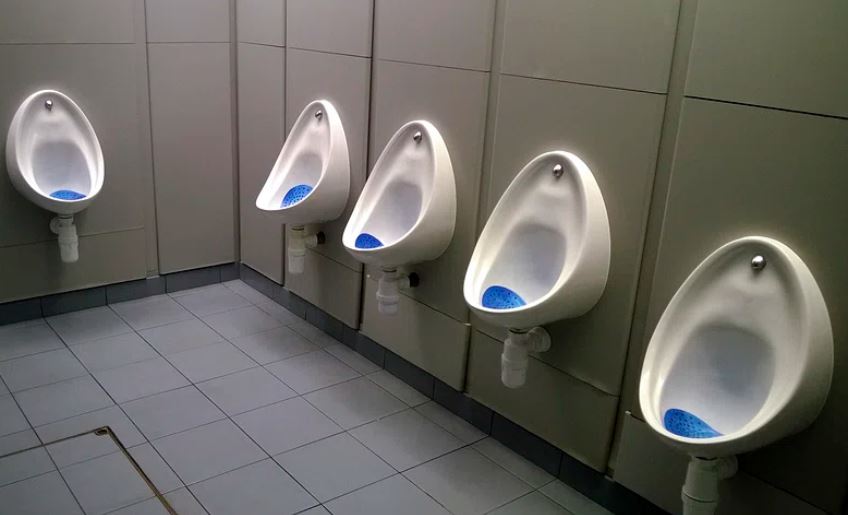Table of Contents
Introduction to Urinal Screens
Urinal screens, also sometimes referred to as urinal cakes or urinal blocks, are fragrance-containing devices that are placed in urinals to help control odor and keep urinals clean. The main purpose of urinal screens is to help block and trap urine odors, as well as provide a pleasant fragrance to bathrooms and restrooms where urinals are present.
Urinal screens are designed to fit into the drain area or urinal trap of a urinal. They typically contain ingredients like fragrance oils, gels, soluble polymers, and other agents that help to control odors. As urine passes through the urinal, the urinal screen helps to trap odors and prevent them from wafting into the restroom air. The fragrance oils and gels are slowly released to provide a pleasant smell.
Many public restrooms, schools, offices, restaurants, bars, stadiums, and other facilities use urinal screens as a simple and effective way to keep odors under control. They provide a better bathroom experience for users compared to unmanaged urinals. Urinal screens come in many shapes, sizes, and fragrances to suit different needs. Properly using urinal screens is an important part of restroom maintenance and creating a pleasant environment.
Types of Urinal Screens
There are a few different types of urinal screens that serve various functions:
- Plastic screens – These are the most common and inexpensive type of urinal screen. They are made of thin plastic mesh that allows liquid to pass through while catching debris. Plastic screens are durable but not eco-friendly.
- Biodegradable paper screens – For a more environmentally-friendly option, biodegradable paper screens dissolve over time. They are compostable and break down quickly after disposal. Paper screens may need to be replaced more frequently than plastic.
- Antibacterial screens – These urinal screens have an antibacterial treatment or coating to help prevent bacteria growth. The additive inhibits bacterial odors and stains. Antibacterial screens provide germ-fighting benefits but cost more than regular screens.
- Enzyme-infused screens – Enzyme urinal screens contain special enzymes that help break down urine deposits and organic matter. This helps keep drains clear and reduce odors. The enzymes work to digest waste and oils over time.
- Scented screens – Perfumed or scented urinal screens help mask unpleasant bathroom odors. They contain fragrances and essential oils that provide air freshening benefits. Scent options like citrus, vanilla or pine add light fragrance.
- Screenless urinal filters – Instead of using a screen, some filters sit flush inside the urinal drain. They have a cartridge design that captures debris without a mesh screen. This screenless approach can increase flow.

The material and any specialty additives account for the differences between the types of urinal screens available. Plastic screens are affordable and durable, while paper and antibacterial screens offer more benefits. Scented, enzyme and screenless filters also serve various functions for optimizing urinals.
Benefits of Using Urinal Screens
Urinal screens provide several benefits compared to urinals without screens:
Odor Control
Urinal screens contain fragrance blocks or pads that release a pleasant scent into the air. The fragrance helps to mask and neutralize unpleasant odors from the urinal, keeping restrooms smelling fresh. The scent is released gradually over time. Some urinal screen systems allow fragrance cartridges to be replaced periodically to maintain ongoing odor control.
Splash Reduction
The mesh screen on a urinal device captures urine splashes that would otherwise spray out of the urinal. This helps keep restroom floors and walls cleaner by preventing splashes from escaping the urinal. Less splashing also contributes to odor control.
Cleaner Restrooms
The combination of odor control and splash reduction makes restrooms equipped with urinal screens cleaner and more pleasant to use. The visual barrier of the screen also helps limit the spread of germs. With reduced odors, splashes, and germs, bathrooms stay cleaner longer after cleaning. This improves the restroom experience for users.
Choosing the Right Urinal Screen
When selecting a urinal screen, there are a few key factors to consider:
Size
Urinal screens come in different sizes to fit standard urinals. Measure the dimensions of your urinal before purchasing a screen to ensure a proper fit. The screen should sit flat and cover the entire area inside the urinal bowl. An improperly sized screen may leave open gaps or not fully cover the drain opening.
Shape
The shape of the urinal screen should match the contour of your urinal bowl. Oval, rectangular, and corner screens are available for the various urinal designs. Pick the shape that will have full contact with the sides of the urinal. This prevents urine from getting behind or around the edges of the screen.
Drainage
An effective urinal screen allows liquid to drain through small holes or mesh while trapping debris. The drainage capacity must be adequate for the urinal’s usage level to prevent overflow. Look for screens made from stainless steel or zinc with laser-cut holes or stainless steel mesh for optimal drainage flow.
Cost
Urinal screen prices range from $2 – $20 depending on the size, shape and materials. Less expensive plastic models may warp or degrade over time, requiring more frequent replacement. Investing in a higher quality stainless steel or zinc screen will provide more durability and value over the long-term.
Installing and Maintaining Urinal Screens
Keeping urinals clean and odor-free requires proper installation, regular cleaning, and replacing urinal screens at the right interval. Here are some tips for optimal urinal screen maintenance:
Installation
- Read the manufacturer’s instructions for your specific urinal screen. Methods may vary.
- Insert the urinal screen flat side up into the urinal drain pipe. Push it in fully so it sits firmly in place.
- Ensure any attachment hooks or adhesives are properly secured as per instructions. The screen should not wiggle or move.
- Forprivacy screens, insert into designated tracks or clips. Adjust as needed for optimal coverage.
Cleaning
- Urinal screens should be cleaned frequently, either daily or severaltimes per week depending on usage.
- Remove the screen and rinse under warm water. Use a soft brush or cloth to remove any mineral deposits.
- Some screens are dishwasher safe for easy cleaning. Check the product details.
- Disinfect and deodorize using a diluted bathroom cleaner or bleach solution.
- Rinse thoroughly and allow to fully dry before reinstalling.
Replacement
- Over time, urinal screens can become oversaturated with odor and stains. Replace per the manufacturer’s recommendation, usually every 1-3 months.
- Look for signs it is time to replace like a strong lingering odor,visible staining, or buildup that can’t be removed through cleaning.
- Consider more frequent replacement in high traffic restrooms.
- Have spare screens on hand for easy swap outs when needed.
Following proper installation, cleaning, and replacement guidelines will keep urinals fresh, prevent clogs, and extend the life of your urinal screen. Consistent maintenance ensures optimal performance.
Introduction to Urinal Drain Cleaners
Urinal drain cleaners serve an important purpose in commercial restrooms and public bathrooms – keeping urinal drains free-flowing and odor-free. Buildup from urine, limescale, rust, and other debris can lead to clogged and smelly drains over time. Urinal drain cleaners work to break down this buildup through chemical reactions, restoring proper drainage and eliminating unpleasant odors.
There are a few main types of urinal drain cleaners on the market:
- Acid-based cleaners – These contain strong acids like sulfuric or hydrochloric acid to dissolve mineral deposits and buildup. They work quickly but can be harsh.
- Alkaline or caustic cleaners – Contain sodium hydroxide, potassium hydroxide or other alkaline compounds to saponify fats and oils. Less harsh than acid cleaners.
- Enzyme or bacteria cleaners – Use enzymes or bacterial cultures to digest organic matter clogging drains. More natural but slower acting.
- Foaming cleaners – Feature surfactants to lift, trap and flush away debris. Can supplement other drain cleaner types.
- Oxidizing cleaners – Use oxidizers like sodium hypochlorite to degrade contaminants. Good at removing stains.
The right urinal drain cleaner depends on the specific clog, pipes, plumbing codes, and maintenance needs. Proper use at regular intervals helps prevent major clogs from forming in urinals.
Active Ingredients in Drain Cleaners
Urinal drain cleaners contain a variety of active ingredients that help break down and dissolve organic matter that causes clogs and buildup. Some of the key active ingredients to look for include:
Enzymes
Enzymes are proteins that catalyze or accelerate chemical reactions. Drain cleaner enzymes help digest organic matter like urine, tissue, hair, and food particles that go down the drain. Common enzyme cleaners include amylase, protease, lipase, and cellulase. These enzymes break down starches, proteins, fats, and cellulose respectively. Using an enzyme cleaner regularly can help prevent buildup and keep drains free-flowing.
Acids
Acid ingredients like sulfuric, hydrochloric, or phosphoric acid help dissolve mineral deposits, soap scum, hard water scale, and rust that can clog drains. However, concentrated acids can be dangerous if used improperly. Look for drain cleaners that contain diluted acid solutions for safety. Acids help dissolve inorganic matter that other ingredients may not break down.
Antibacterial Agents
To kill germs and sanitize drains, many drain cleaners contain antibacterial ingredients like bleach, peroxide, or quaternary ammonium compounds. These help eliminate bacteria and odors that develop from organic matter accumulating in drains. However, quaternary ammonium compounds are thought to be less harmful to pipes than bleach over time. Regular use of antibacterial drain cleaners can help maintain more hygienic drain conditions.
Using drain cleaners with a strategic blend of enzymes, diluted acids, and antimicrobials can help keep urinal drains free of the various gunk, grime, and buildup that occurs over time. Choose cleaners with safe ingredients and follow directions to allow the cleaners to work optimally.
Using Urinal Drain Cleaners
Using urinal drain cleaners properly is important for both safety and effectiveness. Here are some tips:
- Read the directions on the drain cleaner bottle thoroughly before use. Pay close attention to any safety warnings or precautions.
- Wear proper protective gear like gloves and eye protection. The chemicals in drain cleaners can cause burns or irritation.
- Only use drain cleaners specifically designed for urinals and restroom drains. Do not use a general sink or tub drain cleaner.
- Remove any debris from the urinal drain before pouring in the cleaner. This allows the chemicals to work directly on any buildup or clog.
- Pour the drain cleaner directly into the urinal drain according to the product directions. Often 6-8 ounces is recommended for a standard urinal drain.
- Let the drain cleaner sit for the specified amount of time, usually 10-30 minutes. This gives the chemicals time to break down the clog.
- Flush the urinal thoroughly with hot water after the recommended contact time. This will rinse away any remaining debris and chemicals.
- Use drain cleaners on a regular maintenance schedule, such as monthly, to prevent major clogs from forming. Do not wait until the drain is completely clogged.
- If the urinal is still draining slowly after one treatment, repeat the process until the drain is cleared. Severe clogs may take multiple applications.
- Never mix different drain cleaners together, as this can cause dangerous chemical reactions.
- Properly dispose of any leftover drain cleaner according to the product label. Do not pour it down a sink.
Following the proper usage directions is key to safely and effectively clearing urinal drains with commercial cleaners. Consistent monthly maintenance can prevent major clogging issues.

Benefits of Urinal Drain Cleaners
Urinal drain cleaners provide several key benefits for maintaining restroom hygiene and plumbing:
Clearing Clogs
Drain cleaners contain powerful active ingredients designed to break down and dissolve clogs caused by uric salt deposits, organic matter, hair, and other debris. Regular use of drain cleaners helps keep drains flowing freely and prevent backups. Look for drain cleaners with sodium hydroxide or sulfuric acid that actively eat away and dissolve blockages.
Odor Removal
Bacteria and residue collecting in urinal drains can produce foul odors. Drain cleaners sanitize and deodorize with disinfectants and fragrances that destroy bacteria and mask unpleasant smells. Opt for cleaners containing quaternary ammonium compounds that sanitize and eliminate odors at the source.
Preventing Buildup
Using drain cleaners on a regular basis helps prevent the buildup of uric salt sediments and organic matter that lead to clogs and malfunctioning drains. Maintaining free-flowing drains requires regularly applying drain cleaners to keep pipes clear of gradual buildup over time. Seek heavy-duty enzymatic or acidic drain cleaners that digest uric salts and dissolve scale.
By clearing clogs, removing odors, and preventing gradual buildup, urinal drain cleaners are an effective maintenance solution for optimizing restroom hygiene and plumbing performance. Regular use provides major benefits compared to resorting to plumbers for drain repairs.
Choosing the Best Drain Cleaner
When selecting a urinal drain cleaner, there are a few key factors to consider:
Form
Urinal drain cleaners come in liquid, gel, foam, or powder forms. Liquids can spread easily into pipes but may splash when poured. Gels and foams stick to surfaces better. Powders need water to activate but are easy to sprinkle directly into drains. Consider which form will work best for your urinals’ drain configuration.
Fragrance
Look for drain cleaners with pleasant fragrances or odor neutralizers. Unpleasant chemical smells from urinal drains can be off-putting in restrooms. Opt for cleaners with fragrances like citrus, mint, or pine that help mask drain odors. Avoid overpowering perfumes that could cause headaches.
Strength
Check the active ingredients and concentration. Strong alkaline drain cleaners with sodium hydroxide or potassium hydroxide can dissolve thick buildups of uric salt crystals and organic matter. However, they require caution in handling. For routine maintenance, look for cleaners with bacteria-fighting properties to prevent clogs.
Cost
Compare costs of various commercial drain cleaner brands and generic or store brand options. Consider dilution ratios when comparing, as concentrated cleaners may offer more value but require mixing with water. Also factor in required frequency of use. Amore affordable cleaner that must be used more often may end up costing more than one with a higher upfront price but longer-lasting effects.
Choosing the best urinal drain cleaner involves balancing form, fragrance, strength, and cost factors to suit your facility’s specific needs and budget. Prioritize dissolving power for problem drains but opt for gentler cleaners for regular maintenance. With some product research, you can find an effective option to tackle drain clogs and keep urinals smelling fresh.




